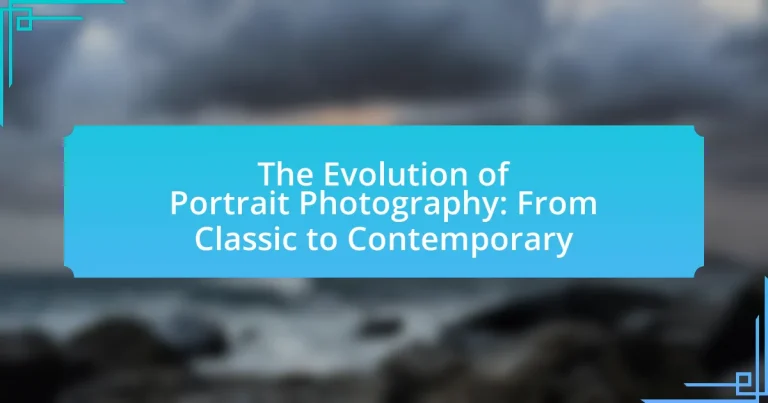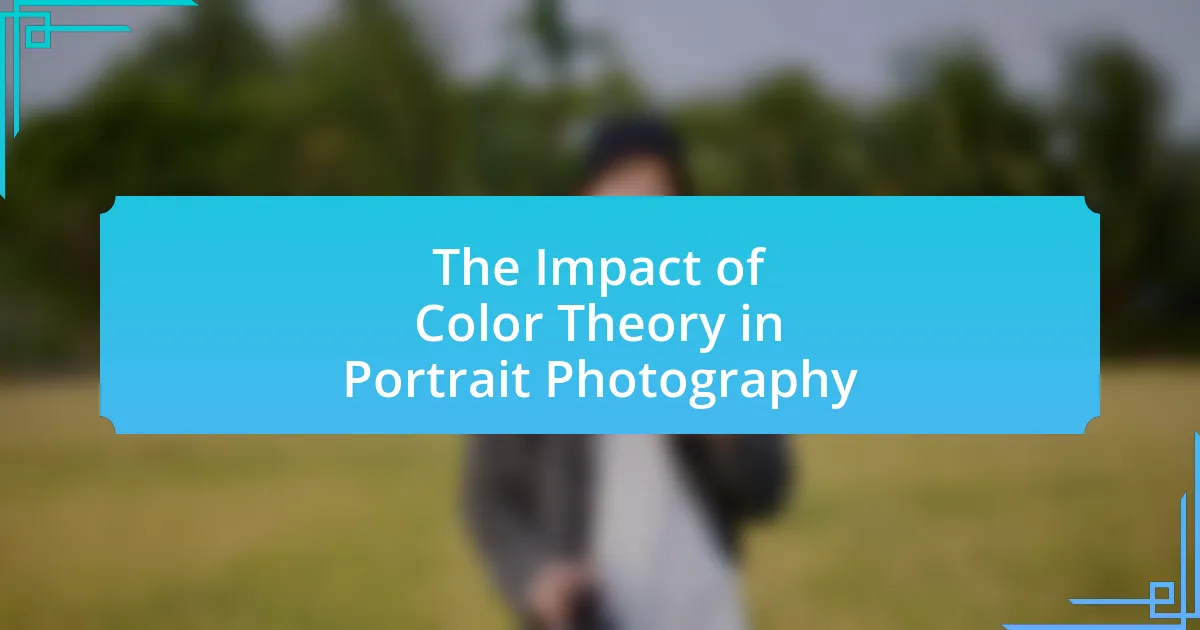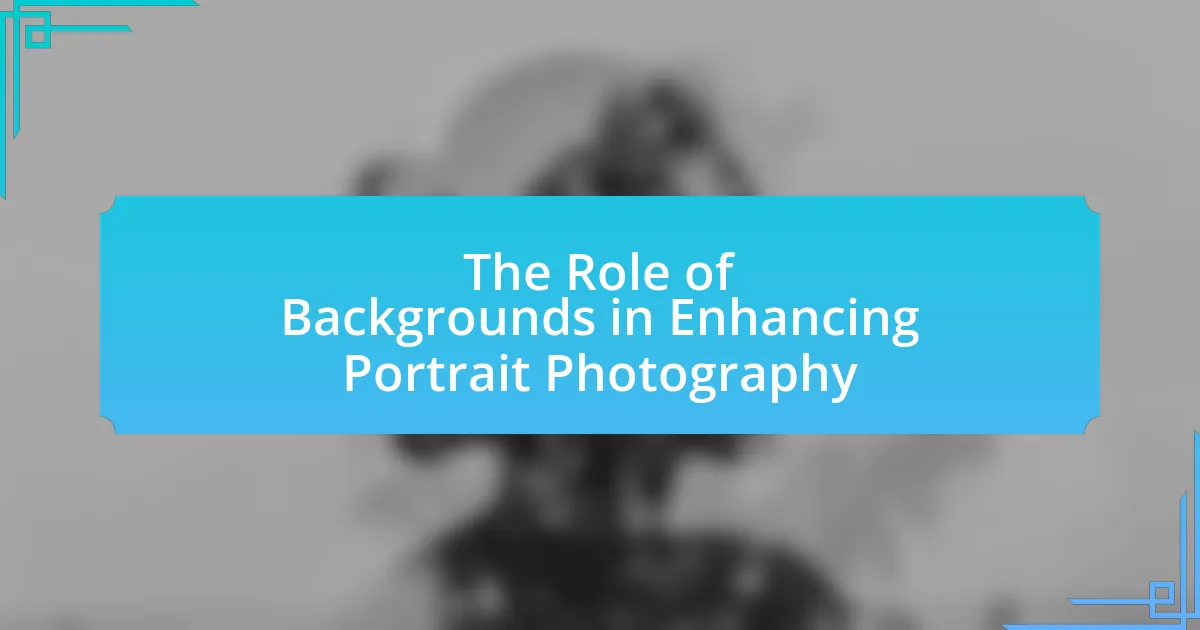The article examines the evolution of portrait photography, tracing its development from the early 19th century with the invention of the daguerreotype to contemporary digital practices. Key milestones include the transition from painted portraits to photographic representations, advancements in film technology, and the rise of color photography. The article highlights how technological innovations have influenced styles and accessibility, shifting the focus from formal poses to candid expressions. Additionally, it explores the impact of cultural influences and social media on modern portrait photography, emphasizing themes of identity and representation.
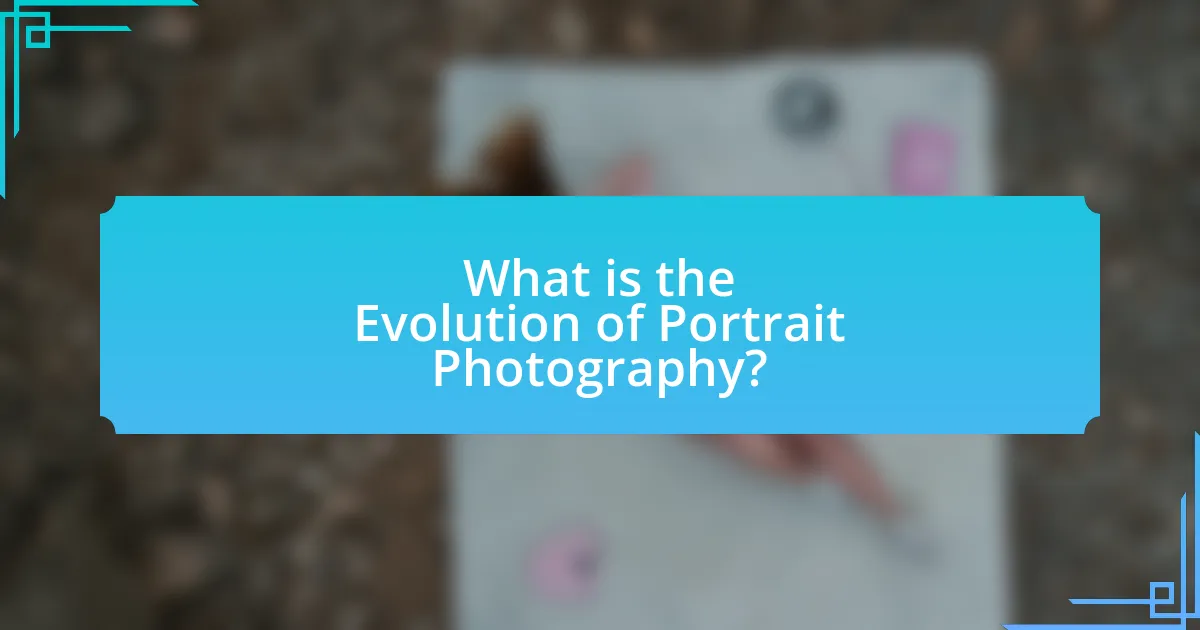
What is the Evolution of Portrait Photography?
The evolution of portrait photography began in the early 19th century with the invention of the daguerreotype, which allowed for detailed and permanent images. This process, developed by Louis Daguerre in 1839, marked the transition from painted portraits to photographic representations, making portraiture more accessible to the public. As technology advanced, the introduction of roll film in the late 19th century and the development of more portable cameras enabled photographers to capture candid and spontaneous moments, shifting the focus from formal poses to more natural expressions. By the mid-20th century, color photography became prevalent, further transforming portrait styles and allowing for greater emotional depth and realism. Today, digital photography and editing software have revolutionized portrait photography, enabling a wide range of artistic expressions and styles, from traditional to contemporary.
How has portrait photography changed over time?
Portrait photography has evolved significantly from the early days of painted portraits to modern digital photography. Initially, portrait photography was a luxury, accessible only to the wealthy, and involved long exposure times that required subjects to remain still for several minutes. With the invention of the daguerreotype in the 1830s, portraits became more accessible, allowing for quicker capture times and a broader audience.
The introduction of color film in the mid-20th century further transformed portrait photography, enabling more vibrant and realistic representations. The rise of digital photography in the late 20th century revolutionized the field, allowing for instant review and editing, which changed how portraits are created and shared. Today, portrait photography incorporates various styles, including candid and lifestyle photography, reflecting contemporary culture and technology, such as social media platforms that emphasize personal branding and visual storytelling.
These advancements illustrate a shift from formal, posed portraits to more dynamic and diverse representations of individuals, showcasing the ongoing evolution of portrait photography.
What were the key milestones in the history of portrait photography?
The key milestones in the history of portrait photography include the invention of the daguerreotype in 1839, which marked the first practical method of capturing images, allowing for detailed portraits. The introduction of the tintype in the 1850s made photography more accessible and affordable, further popularizing portrait photography. The development of roll film in the late 19th century by George Eastman revolutionized the field, enabling amateur photographers to take portraits easily. The advent of color photography in the mid-20th century expanded artistic possibilities, while digital photography in the late 20th century transformed the medium, allowing for instant capture and editing of portraits. Each of these milestones significantly influenced the evolution and accessibility of portrait photography.
How did technological advancements influence portrait photography?
Technological advancements significantly influenced portrait photography by enhancing image quality, accessibility, and creative possibilities. The introduction of the daguerreotype in the 1830s allowed for detailed and permanent images, revolutionizing how portraits were captured. Later, the development of roll film in the late 19th century made photography more accessible to the general public, leading to a surge in portrait photography. The advent of digital cameras in the late 20th century further transformed the field by enabling instant review and editing of images, which increased experimentation and creativity among photographers. Additionally, advancements in software for photo editing, such as Adobe Photoshop, have allowed for extensive manipulation of portraits, enabling artists to push the boundaries of traditional photography. These technological changes have collectively shaped the evolution of portrait photography from classic techniques to contemporary practices.
Why is understanding the evolution of portrait photography important?
Understanding the evolution of portrait photography is important because it reveals how societal values, technological advancements, and artistic movements have shaped visual representation over time. The transition from early painted portraits to modern digital photography illustrates changes in accessibility, aesthetics, and cultural significance. For instance, the introduction of the daguerreotype in the 1830s made portrait photography more accessible to the general public, democratizing art and altering social dynamics. Additionally, studying this evolution helps to contextualize contemporary practices and informs current trends in identity representation, as seen in the rise of social media photography.
What insights can we gain from studying its history?
Studying the history of portrait photography reveals the evolution of artistic expression and technological advancements in capturing human likeness. This evolution showcases how early techniques, such as daguerreotypes in the 19th century, laid the groundwork for modern photography, influencing styles and societal perceptions of identity. For instance, the transition from formal, posed portraits to candid photography reflects changing cultural values and the democratization of image-making, as seen in the rise of snapshot photography in the 20th century. Additionally, understanding historical context, such as the impact of social movements on representation in portraiture, provides insights into how photography has shaped and been shaped by societal norms and individual identity.
How does the evolution reflect societal changes?
The evolution of portrait photography reflects societal changes by illustrating shifts in cultural values, technological advancements, and social dynamics. For instance, the transition from formal, posed portraits in the 19th century to candid, spontaneous images in the 20th century signifies a move towards individualism and authenticity in society. This change is evidenced by the rise of snapshot photography, which democratized image-making and allowed for personal expression, aligning with the broader cultural movements of the time, such as modernism and the counterculture of the 1960s. Additionally, the advent of digital photography in the 21st century has further transformed portraiture, enabling instant sharing and global connectivity, which reflects the increasing importance of social media and online identity in contemporary society.
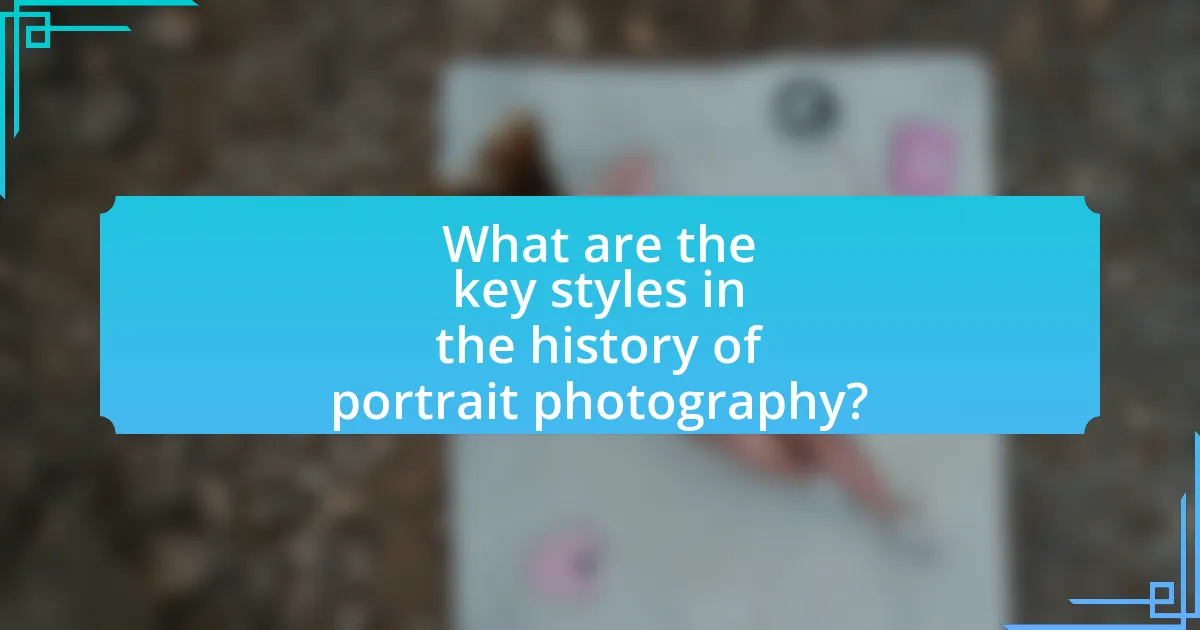
What are the key styles in the history of portrait photography?
The key styles in the history of portrait photography include classical portraiture, environmental portraiture, candid photography, and contemporary portraiture. Classical portraiture, prominent from the 19th century, focused on formal poses and studio settings, often emphasizing the subject’s status and personality. Environmental portraiture emerged later, showcasing subjects in their natural surroundings, which added context and narrative to the image. Candid photography gained popularity in the 20th century, capturing spontaneous moments and emotions, reflecting a more authentic representation of individuals. Contemporary portraiture incorporates diverse styles and techniques, often blending traditional and modern elements, influenced by digital technology and social media trends. Each style has evolved to reflect cultural shifts and advancements in photographic techniques, demonstrating the dynamic nature of portrait photography throughout history.
What characterized classic portrait photography?
Classic portrait photography is characterized by its emphasis on formal composition, controlled lighting, and the portrayal of the subject’s personality and status. This style often utilized techniques such as soft focus and chiaroscuro to create depth and dimension, highlighting the subject’s features while maintaining a sense of elegance. Historically, classic portrait photography was influenced by painting traditions, leading to poses and settings that conveyed authority and sophistication, as seen in the works of photographers like Julia Margaret Cameron and Edward Weston.
How did lighting and composition play a role in classic styles?
Lighting and composition were fundamental in defining classic styles of portrait photography by enhancing the subject’s features and creating a mood. Classic photographers utilized natural light and controlled artificial lighting to achieve soft shadows and highlights, which emphasized the subject’s facial structure and expression. For instance, the use of Rembrandt lighting, characterized by a triangular patch of light on the cheek opposite the light source, became a hallmark of classic portraiture, adding depth and dimension. Additionally, composition techniques such as the rule of thirds and leading lines guided the viewer’s eye toward the subject, ensuring that the focus remained on the individual being portrayed. Historical examples, such as the works of 19th-century photographers like Julia Margaret Cameron, illustrate how these elements were meticulously crafted to convey emotion and narrative, solidifying the importance of lighting and composition in classic styles.
What techniques were commonly used in classic portrait photography?
Classic portrait photography commonly utilized techniques such as soft lighting, posed compositions, and the use of backdrops. Soft lighting was achieved through diffused natural light or artificial sources to create flattering skin tones and reduce harsh shadows. Posed compositions involved careful arrangement of subjects to convey personality and emotion, often using props or specific angles to enhance the visual narrative. Backdrops, ranging from simple fabric to elaborate painted scenes, were employed to provide context and depth, helping to focus attention on the subject. These techniques were foundational in establishing the aesthetic standards of portrait photography during its early development.
What defines contemporary portrait photography?
Contemporary portrait photography is defined by its emphasis on individuality, authenticity, and the integration of modern technology and diverse cultural influences. This genre often utilizes innovative techniques such as digital manipulation, unconventional compositions, and varied lighting to capture the subject’s personality and context. For instance, contemporary photographers like Annie Leibovitz and Martin Schoeller employ unique styles that reflect personal narratives and societal themes, showcasing the evolution from traditional posed portraits to dynamic, expressive representations. The shift towards inclusivity and representation in contemporary portrait photography further highlights its focus on diverse identities and experiences, making it a reflection of current social dynamics.
How do modern techniques differ from classic approaches?
Modern techniques in portrait photography differ from classic approaches primarily through the use of advanced technology and innovative methods. Classic approaches often relied on manual processes, such as film development and traditional lighting setups, which limited flexibility and creativity. In contrast, modern techniques utilize digital cameras, software for editing, and artificial intelligence, allowing for greater experimentation with lighting, composition, and post-processing. For example, the introduction of digital photography in the late 20th century revolutionized the field by enabling instant feedback and adjustments, which were not possible with classic film methods. Additionally, modern techniques often incorporate social media and online platforms for sharing and promoting work, expanding the reach and impact of portrait photography beyond traditional galleries.
What themes are prevalent in contemporary portrait photography?
Contemporary portrait photography prominently features themes of identity, diversity, and social commentary. Identity is explored through personal narratives and self-representation, allowing subjects to express their individuality. Diversity is highlighted by showcasing a wide range of cultures, body types, and gender identities, reflecting society’s evolving understanding of representation. Social commentary is often integrated, addressing issues such as race, gender, and mental health, which resonate with current societal conversations. These themes are supported by the rise of platforms like Instagram, where photographers and subjects alike engage in dialogues about identity and representation, making contemporary portrait photography a dynamic medium for exploring and challenging societal norms.
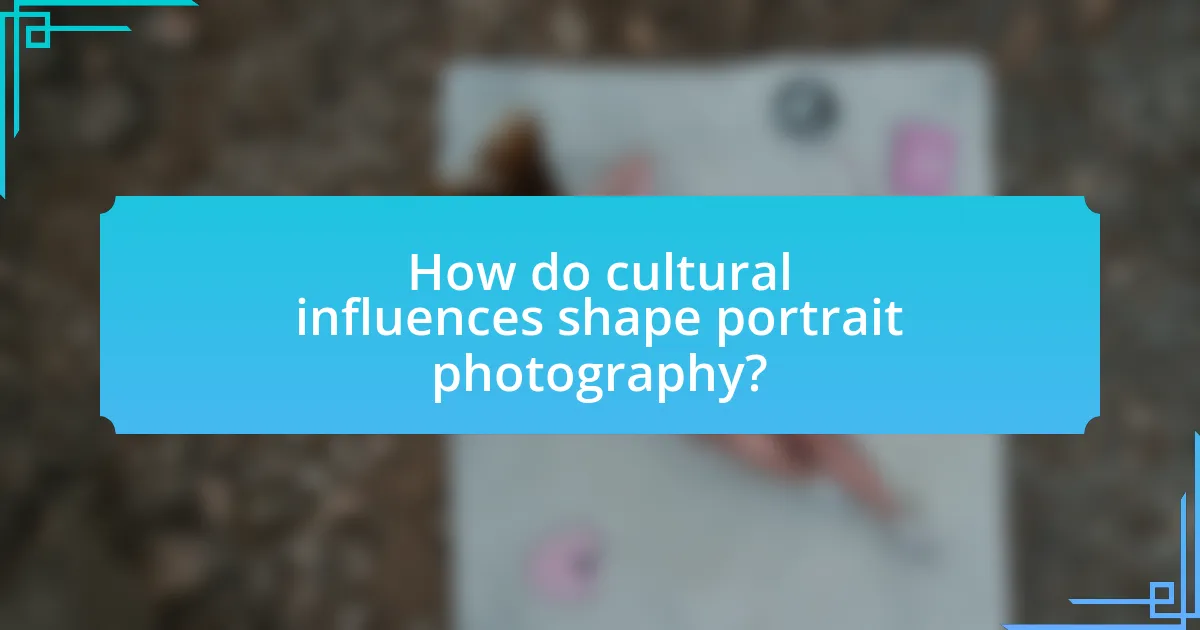
How do cultural influences shape portrait photography?
Cultural influences shape portrait photography by dictating the themes, styles, and subjects that are emphasized in the images. For instance, in Western cultures, portrait photography often highlights individualism and personal expression, reflecting societal values that prioritize the self. In contrast, many Asian cultures may focus on family and community, leading to group portraits that emphasize collective identity. Historical context also plays a role; for example, during the Renaissance, portraiture was used to convey status and power, influenced by the cultural emphasis on humanism and individual achievement. Additionally, cultural norms regarding attire, poses, and settings inform the visual language of portrait photography, as seen in traditional attire used in portraits across various cultures, which signifies heritage and identity.
What role does culture play in portrait photography styles?
Culture significantly influences portrait photography styles by shaping the themes, aesthetics, and techniques used in capturing subjects. Different cultures have unique traditions, values, and visual languages that inform how individuals are portrayed, affecting aspects such as clothing, poses, and settings. For instance, in Western cultures, portrait photography often emphasizes individualism and personal expression, while in many Asian cultures, group portraits may highlight familial connections and social hierarchy. Historical context also plays a role; for example, the use of specific color palettes or symbolic elements can reflect cultural beliefs or social status. This cultural interplay is evident in the works of photographers like Yousuf Karsh, who captured the essence of his subjects through culturally relevant contexts, demonstrating how culture can enhance the narrative and emotional depth of portrait photography.
How have different cultures contributed to the evolution of portrait photography?
Different cultures have significantly influenced the evolution of portrait photography by introducing diverse artistic styles, techniques, and subject matters. For instance, the introduction of the daguerreotype in the 19th century in Europe allowed for detailed and realistic representations, which were further enhanced by cultural practices such as the emphasis on individualism in Western societies. In contrast, cultures in Asia, particularly in Japan, contributed to the art of portraiture through the use of ukiyo-e prints, which emphasized stylization and narrative elements, influencing the aesthetic approach to photography. Additionally, African cultures have historically utilized portraiture in ceremonial contexts, showcasing identity and social status, which has informed contemporary practices in portrait photography that focus on cultural representation and storytelling. These cultural contributions have collectively shaped the techniques, themes, and purposes of portrait photography throughout its history.
What are some examples of culturally significant portrait photography?
Culturally significant portrait photography includes works such as “American Gothic” by Grant Wood, which reflects American identity during the Great Depression, and “Migrant Mother” by Dorothea Lange, capturing the struggles of displaced families in the 1930s. Additionally, the portraits of Yousuf Karsh, particularly his image of Winston Churchill, symbolize leadership and resilience during World War II. These examples illustrate how portrait photography can encapsulate historical moments and cultural narratives, influencing public perception and understanding of societal issues.
How can we see the impact of social media on portrait photography?
The impact of social media on portrait photography is evident through the increased accessibility and visibility of photographers’ work. Social media platforms like Instagram and Facebook allow photographers to showcase their portraits to a global audience, leading to greater exposure and opportunities for collaboration. According to a study by the Pew Research Center, 72% of adults use social media, which has transformed how photographers connect with clients and market their services. This shift has also influenced trends in portrait styles, as photographers adapt to the preferences and aesthetics popularized by social media users.
What trends in portrait photography have emerged due to social media?
Trends in portrait photography that have emerged due to social media include the rise of candid and lifestyle photography, increased use of filters and editing apps, and a focus on authenticity and personal branding. Candid photography captures spontaneous moments, reflecting a more natural and relatable aesthetic that resonates with social media audiences. The proliferation of editing tools, such as Instagram filters, allows photographers to enhance images quickly, creating a distinct visual style that aligns with current trends. Additionally, the emphasis on authenticity encourages individuals to showcase their true selves, leading to a shift away from overly posed portraits. These trends are supported by the fact that platforms like Instagram and TikTok prioritize visually engaging content, influencing photographers to adapt their styles to meet audience preferences.
How has social media changed the way portraits are shared and perceived?
Social media has fundamentally transformed the sharing and perception of portraits by enabling instantaneous distribution and broad accessibility. Platforms like Instagram and Facebook allow users to share portraits with a global audience, leading to a democratization of portrait photography where anyone can showcase their work. This shift has resulted in a significant increase in visual culture, as evidenced by the fact that over 1 billion photos are shared daily on Instagram alone. Additionally, social media influences how portraits are perceived, as users often curate their images to fit aesthetic trends, impacting societal standards of beauty and identity. The immediacy of feedback through likes and comments further shapes the way portraits are created and appreciated, fostering a culture of validation and engagement around visual content.
What are some best practices for modern portrait photography?
Best practices for modern portrait photography include utilizing natural light, engaging with the subject to create a comfortable atmosphere, and focusing on composition and framing. Natural light enhances skin tones and reduces harsh shadows, making the subject appear more flattering. Engaging with the subject fosters a relaxed environment, resulting in more genuine expressions. Additionally, applying the rule of thirds and considering background elements can significantly improve the overall aesthetic of the portrait. These practices are supported by the fact that studies show portraits taken in natural light are often preferred by viewers for their authenticity and warmth.
How can photographers effectively blend classic and contemporary techniques?
Photographers can effectively blend classic and contemporary techniques by integrating traditional composition and lighting methods with modern digital tools and post-processing techniques. For instance, using classic portraiture principles, such as the rule of thirds and natural lighting, alongside contemporary editing software like Adobe Lightroom or Photoshop allows for enhanced creativity and precision. This approach not only preserves the timeless quality of classic photography but also embraces the flexibility and innovation offered by contemporary practices, resulting in a unique and compelling visual narrative.
What tips can enhance the quality of portrait photography today?
To enhance the quality of portrait photography today, photographers should focus on proper lighting, composition, and subject engagement. Utilizing natural light or soft artificial light can create flattering skin tones and reduce harsh shadows. Composition techniques, such as the rule of thirds, help in framing the subject effectively, drawing attention to their features. Engaging the subject through conversation or prompts fosters genuine expressions, resulting in more impactful portraits. Studies show that portraits with strong emotional connections are perceived as more compelling, emphasizing the importance of subject interaction in photography.












